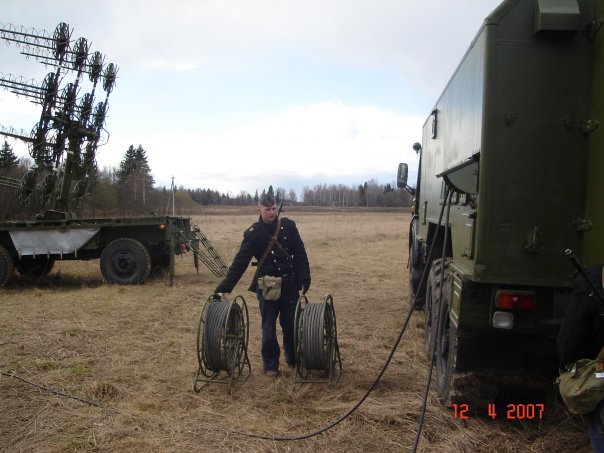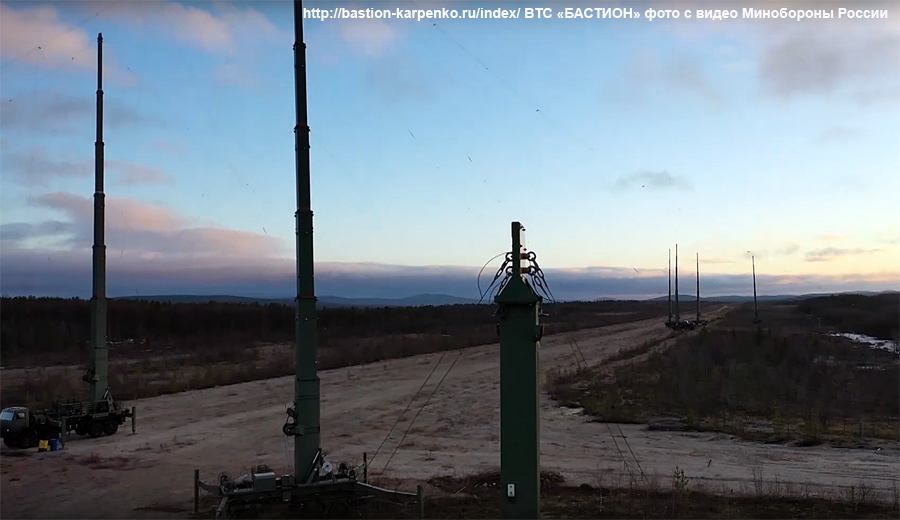Russia gears up for electronic warfare in space (part 1)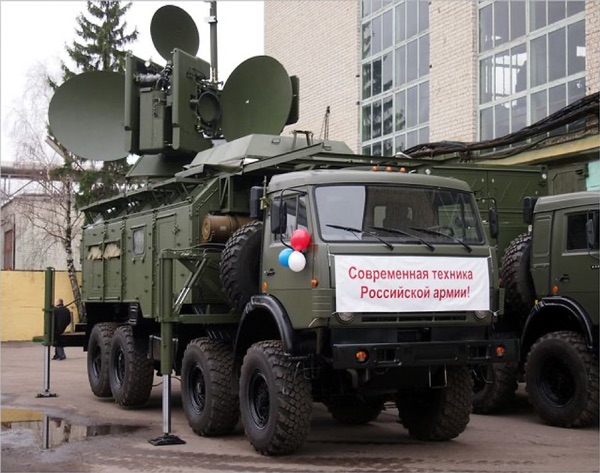
Russia is building up an impressive capability to conduct electronic warfare against foreign satellites. At the center of this effort is the development of a variety of mobile ground-based systems to interfere with the operations of both communications and radar reconnaissance satellites. There is also evidence for plans to perform electronic warfare from space using nuclear-powered satellites. Aside from that, work is underway at various locations in Russia to construct ground-based infrastructure to obtain signals intelligence on foreign satellites and apparently also to protect Russia’s own fleet of satellites against electronic attack from outside.
Electronic warfare is probably perceived by Russia as a relatively inexpensive, asymmetric response to Western military technological development.
Electronic warfare (EW) is traditionally divided into electronic attack (the offensive use of electromagnetic energy against the enemy’s combat capability), electronic protection (the defense against the enemy’s electronic attack systems) and electronic warfare support (the gathering of intelligence on the enemy’s electronic systems). A fourth element added to that in a recent Russian definition of electronic warfare is the development of countermeasures against foreign technical reconnaissance systems, which clearly has been elevated in importance in recent years.[1] One example of that is Peresvet, a truck-mounted laser system probably designed to dazzle or blind sensors of optical reconnaissance satellites trying to follow the movements of mobile ICBM units.[2] While Peresvet, by some definitions of the term, is considered an electronic warfare system, this article will focus only on electronic warfare in the radio part of the electromagnetic spectrum.
Electronic warfare has gained tremendous significance in Russia’s military doctrine over the past decade or so. Its status within the Russian armed forces rose to a new level in 2009 with the establishment of the Electronic Warfare Troops and the formation of a headquarters for the EW commander within the General Staff. This has enhanced coordination within the EW domain, improved the integration with other branches of the armed forces, and facilitated the procurement of new EW technology. Since then, Russia has consistently invested in EW modernization and fielded a variety of new EW systems to augment the capabilities of all service branches. Some of them have been tested on the battlefield in Eastern Ukraine and Syria.
Electronic warfare is probably perceived by Russia as a relatively inexpensive, asymmetric response to Western military technological development. While suppressing enemy command and control systems is a key objective of Russia’s EW program, an equally important goal is to protect the country’s own military personnel, equipment, and infrastructure, such as through the introduction of improved emission control capabilities that reduce the risk of spreading information that leads to detection.[3]
With space-based communication, reconnaissance, and navigation systems playing an ever-increasing role in ensuring the success of military operations, satellites have become a key target for Russia’s EW systems. EW counterspace systems have several obvious advantages over traditional kinetic ASAT systems. They generate no space debris, their effects on a satellite are completely reversible, and they can be narrowly targeted to affect just one of a satellite’s many capabilities.[4]
Tirada-2 and Bylina-MM: jamming communications satellitesSome Russian EW systems are aimed at jamming and spoofing communications user terminals and GPS receivers within a local area (“downlink jamming”). Other types of jammers, however, are designed to interfere with the satellites themselves, affecting services for all users in the satellite reception area (“uplink jamming”). Russia has at least two EW systems specifically intended for uplink jamming of communications satellites. The best known of these is called Tirada-2 (“tirade”), which seems to have had a predecessor in the Soviet days called Tirada-1D. The space-related role of Tirada-2 has been confirmed by several official sources. It was termed a “complex for suppression of space communications” in one in a series of yearbooks on Russia’s electronic warfare program, which are among the few primary sources of information on the program.[5] In late 2017, a Russian military official appearing before a parliamentary defense committee described it as a “mobile complex for the radio-electronic destruction of communications satellites.”[6] In early 2018, an anonymous source within Russia’s military industrial complex told the Interfax news agency that Tirada-2 was capable of “disabling communications satellites”, adding it was a “multimillion [ruble] project.”[7]
There are at least two accounts of EW units testing jammers against operational communications satellites, although it is not known if these were Russian or foreign satellites.
The wording used in these statements would suggest that, if necessary, Tirada-2 could be used to inflict permanent damage to onboard satellite communications systems, although it is impossible to verify whether this is really the case. One observer writing for the military weekly “Zvezda” claimed that Tirada-2 can completely overwhelm electronic protection systems of satellites, forcing them to spend all their electrical power on trying to counter the jamming signals and thus robbing them of the ability to relay signals to the ground. He underlined that Tirada-2 is not merely an upgrade of its Soviet-era predecessor, but a totally new electronic warfare system.[8]
As can be determined from several court documents, Tirada-2 officially got underway on December 19, 2001, with a contract awarded by the Ministry of Defense to the Vladimir Design Bureau of Radio Communications (VKBR) (Vladimir is a town some 200 kilometers east of Moscow). Among its subcontractors are the Vladimir Radio Equipment Factory (which seems to be in charge of serial production), the Radio Research and Development Institute (NIIR), NPP Istok, the Moscow Radiotechnical Scientific Research Institute (MNIRTI), and NPO PM-Razvitiye (a daughter company of ISS Reshetnev, a manufacturer of communications and navigation satellites.) Publicly available official documents mention systems called Tirada-2S, Tirada-2.2, Tirada-2.3 (also referred to as RB-371A), and Tirada-2.4, which seem to be different iterations of the same system. All four systems were under development before 2010. The NIIR institute was awarded a contract for Tirada-2.2, 2.3, and 2.4 by VKBR on January 1, 2007.[9]
The different versions of Tirada-2 may be designed to cover different parts of the radio spectrum. It is known from a handful of online sources that some EW units specialize in satellites operating in the “decimeter band” (corresponding to ultra high frequency or UHF, the frequency range between 300 megahertz and 3 gigahertz) and others in satellites using the “centimeter band” (corresponding to super high frequency (SHF), the frequency range between 3 and 30 gigahertz). The “S” in Tirada-2S may stand for the Russian word for “centimeter”. Some annual reports of the Vladimir Radio Equipment Factory mention work to adjust equipment of Tirada-2S at frequencies “up to 14 GHz,” which is in the centimeter band.
There are at least two accounts of EW units testing jammers against operational communications satellites, although it is not known if these were Russian or foreign satellites. These units are referred to in some sources as REB-K units (“REB” being the Russian acronym for electronic warfare and “K” standing for “space”). In one of the tests, conducted during the Vostok-2010 military exercise, a mobile EW complex moved to the required location after having received coordinates from a control center in Moscow, calculated the azimuth and elevation of a satellite operating in the centimeter band and successfully jammed its communication systems.[10] Another REB-K unit received two orders to jam communications satellites operating in the decimeter band in the course of the Vostok-2014 exercise and the success of both operations was confirmed by what are called “representatives from outside organizations.”[11] Presumably, such tests are routinely conducted during military exercises. Neither of these tests, however, can be positively linked to Tirada-2.
Having started at the beginning of the century, Tirada-2 has clearly suffered numerous delays, as is borne out by a few rare court documents and company annual reports published online. At least some of the delays may have been caused by Western-imposed economic sanctions, which have forced many companies in Russia’s defense and space industry to switch from imported to domestically built electronic components. Problems resulting from this “import substitution policy” have at least to some extent also affected Tirada-2. As part of this policy, the Vladimir Radio Equipment Factory received an order from the prime contractor (VKBR) in 2015 to build a “high-voltage power module” needed for the serial production of Tirada-2S, but its development apparently ran into trouble and was halted in 2018.[12]
Despite all the delays, indications are that Tirada-2 has reached at least some level of operational capability. In December 2018, the Ministry of Defense published a statement on its website saying that the system would enter service in Russia’s Central Military District the following year and once again underlined its ability to “completely disable communications satellites.”[13]
The three other versions of Tirada-2 may follow suit soon. During a military exhibition in August 2018, it was publicly announced that the Ministry of Defense had placed an order with the Vladimir Radio Equipment Factory for the delivery of Tirada-2.3 complexes beginning later that year. Procurement documents show that as part of this order, the factory had awarded a contract to the NIIR institute on May 30, 2018. NIIR subsequently teamed up with NPP Istok to develop a “transmitting device” for Tirada-2.3, which incorporates components such as traveling-wave tubes, microwave amplifiers, and signal spectrum transformation systems.[14] NIIR received a contract for similar work on Tirada-2.2 and 2.4 on November 11, 2019, under two separate government contracts awarded to the Vladimir Radio Equipment Factory on October 31, 2019.[15]
In April 2019, the Special Monitoring Mission to Ukraine of the Organization for Security and Co-operation in Europe (OSCE) reported that one of its unmanned aerial vehicles had spotted a Tirada-2S truck in the Donbas region in Eastern Ukraine the month before. However, subsequent analysis by the Digital Forensic Research Lab indicated that the vehicle seen in the imagery more likely was another EW system called R-934BMV.[16] This conclusion is supported by the fact that one contract which can be linked to Tirada-2.2 calls for the delivery of a KAMAZ-6350 four-axle truck and a ChMZAP-8335 trailer.[17] Neither of these is seen in the OSCE imagery.
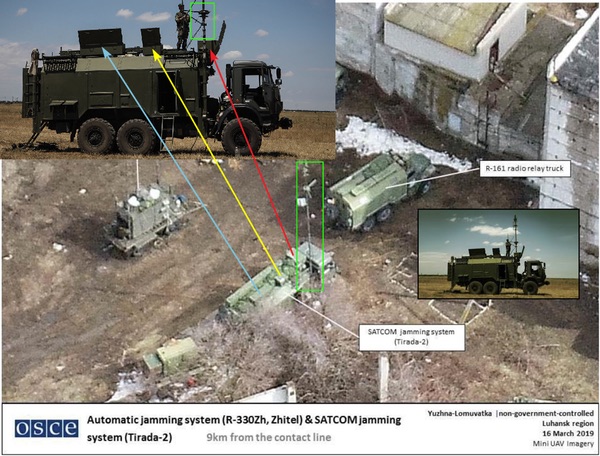
Another picture of what is claimed to be an element of Tirada-2 was taken at the MAKS aerospace show in Moscow in 2013. It shows a model of a KAMAZ-6350 truck that was apparently identified in the display as being part of Tirada-2S and may be the system’s command post. It is not uncommon for mobile EW units to consist of several vehicles, one carrying the actual jamming equipment and others being used for supporting tasks such as command and control and power generation.
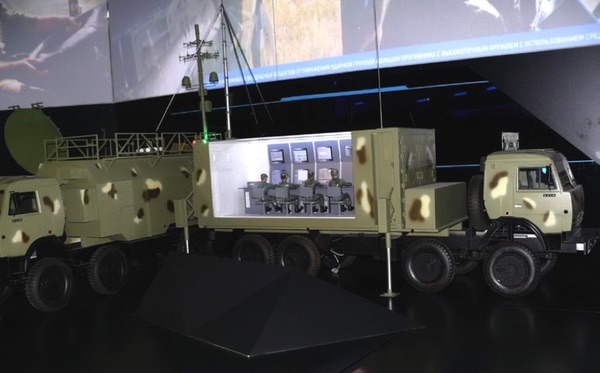 Model of what appears to be the command post of the Tirada-2S satellite jamming system.
Model of what appears to be the command post of the Tirada-2S satellite jamming system.Another ground-based mobile EW system that appears to be specifically designed to jam satellite communication channels is called Bylina-MM (“bylina” is a word used to denote a traditional Russian oral epic poem.) Its existence was revealed in yearbooks on Russia’s EW program published in 2014 and 2015. Articles contributed by the Moscow-based MNIRTI institute identified it as an EW system targeting satellites operating in the “millimeter band,” which corresponds to extremely high frequency (EHF), the band in the electromagnetic spectrum from 30 to 300 gigahertz.
Indications are that Bylina-MM is part of a much larger EW project.
According to the articles, work on Bylina-MM had benefited from theoretical studies conducted jointly with the Institute of Applied Physics (IPF) under research projects called Tirada-EB (2008–2010), Trakt-F (2010–2012) and Vakuum-10 (2011–2013). Tiradа-2 was mentioned alongside Bylina-MM as a project where the results of this research had been applied, suggesting that it is at least partially intended to interfere with satellites operating in this particular frequency range as well. Among MNIRTI’s contributions to the project had been the development of gyrotron traveling wave-tube amplifiers and waveguide transmission lines, which made it possible to develop Russia’s “first automated system to jam satellite communication channels in the millimeter band.” Considering the fact that EHF technology is rapidly evolving, MNIRTI was already working together with other organizations on a next-generation EW system to follow in the footsteps of Bylina-MM.[18]
Further confirmation of Bylina-MM’s space-related role comes in an undated presentation of MNIRTI summing up the results of its joint work with the Institute of Applied Physics under the Trakt-F research project. Here it is described as a system to “suppress the on-board transponders of the millimeter band communications satellites Milstar, GBS, Skynet, Sicral, Italsat and Sakura,” used by “leading foreign countries” and NATO.[19]
Although the MNIRTI presentation seems to date back to early last decade, at least two of the satellite types mentioned here cannot possibly have been targets for Bylina-MM. Italsat and Sakura were Italian and Japanese military communications satellites launched between the 1970s and 1990s that ended their active lifetimes a long time ago. Sicral 1 and 1B are Italian military communications satellites (also used by NATO) launched in 2001 and 2009 (a follow-up satellite, Sicral 2, launched in 2015 does not operate in the EHF band.) Skynet is the name of several generations of satellites providing strategic communication services to the British Armed Forces and NATO. The latest of these was orbited in 2012. GBS (Global Broadcast Service) is not a satellite, but a system that uses direct broadcast satellite technology to transmit video and large data files to US and allied forces. It uses communication payloads on the UHF Follow-On (UFO) and Wideband Global Satcom (WGS) satellites.
Milstar is the name of a series of US Air Force communications satellites launched between 1994 and 2003, four of which are still operational. Their antennas use very narrow beams that provide less opportunity for enemy detection and penetration and can change their gain patterns when a jamming signal is detected. Milstar was succeeded by the Advanced Extremely High Frequency (AEHF) satellites, launched between 2010 and 2020. These incorporate frequency-hopping technology as well as phased array antennas that can adapt their radiation patterns in order to block out potential sources of jamming.
 US Milstar satellites are one of several targets for Bylina-MM. (credit: US Air Force)
US Milstar satellites are one of several targets for Bylina-MM. (credit: US Air Force)Annual reports of NPO PM-Razvitiye have described Bylina-MM as a series of “ground-based mobile automated stations operating in the Ka and V/Ka frequency bands.”[20] The Ka and V bands use frequencies in the 26.5–40 gigahertz and 40–75 gigahertz ranges respectively. The Ka-band is the preferred band for high-performance geostationary communications satellites and is also being increasingly used by low-Earth orbit satellite constellations such as SpaceX’s Starlink. One of the few known applications of the V-band in space communications so far has been the use of 60 gigahertz for crosslink communications between Milstar satellites, a possible sign that these have been a target for interference by Bylina-MM.
Indications are that Bylina-MM is part of a much larger EW project. In recent years, the name Bylina (without “MM”) has been linked by several sources to a highly automated mobile command and control system that uses artificial intelligence to select and recognize targets (not only satellites), determines how to suppress these, and subsequently issues the relevant orders to EW units in the field. The 2017 edition of the EW yearbook identified this system as RB-109A and said its development had been included in the technical specifications for the Bylina project. RB-109A was said to consist of five trucks that maintain contact with the “situation center” of the Electronic Warfare Troops (also known as RB-108S) using satellite communication channels. Unlike earlier command and control systems, RB-109A is a standardized system that can work in conjunction with a wide range of EW complexes aimed at targets on the ground, in the air, or in space. It had undergone successful tests in 2016 together with several EW complexes, including Tirada-2S and what was called Bylina-KV-KRET.[21]
KRET (Concern Radio-Electronic Technologies), which is under the Rostec State Corporation, is the largest holding in Russia’s radio-electronic industry and incorporates some of the country’s leading manufacturers of electronic warfare systems. Asked about KRET’s role in Bylina in an interview in July 2017, the holding’s first deputy director said it had developed “a principally new complex” which could be used for reconnaissance and “for control of jamming stations in the shortwave band.”[22] This apparently was a reference to Bylina-KV-KRET (“KV” is the Russian abbreviation for “shortwave”), but its exact purpose remains unclear.
To confuse matters even more, the Ministry of Defense released a statement in September 2017 in which it used the name Bylina to refer to the automated command system itself and said it was being tested for the first time during the Zapad-2017 military exercises in Russia and Belarus.[23] In April 2017, the Izvestiya newspaper had already referred to RB-109A and Bylina as one and the same thing, reporting that the first Bylina would enter service in 2018 and that all EW units would be equipped with Bylina by 2025.[24]
Whatever the name Bylina exactly stands for, a court document published in 2013 identifies the project’s prime contractor as the Central Scientific Research Institute of Economics, Informatics and Control Systems (TsNII EISU), which received a contract for Bylina from the Ministry of Defense on November 3, 2011, and subsequently subcontracted work on Bylina-MM to MNIRTI on January 10, 2012.[25] The roots of the project may go back further than that because it is also mentioned in the 2010 annual report of a company called VNII Etalon. Other industrial partners involved in Bylina since at least 2011 are the Scientific and Technical Center for Electronic Warfare (NTTs REB) and NPO PM-Razvitiye.
TsNII EISU, which also operates under the wings of the Rostec State Corporation (but is not part of the KRET holding), is a major IT supplier for the Ministry of Defense. An article published on its website acknowledges its role in creating an “automatized electronic warfare control system” (without mentioning the name Bylina.)[26] At least two contracts signed by the company in 2016 can be traced back to the 2011 government contract for Bylina and deal with the testing of software, among other things for the RB-108S EW situation center.[27]
Russia may also be working on an aerial EW capability against orbiting satellites.
In summary, the name Bylina has been used for a command and control system supporting a wide variety of EW complexes, but also refers to at least two EW systems operating in different parts of the radio spectrum (Bylina-KV and Bylina-MM), with the latter being specifically aimed at communications satellites. No pictures of Bylina-MM have ever been released and it is not known if the system has been operationally deployed. The latest openly available reference to Bylina-MM is in the 2018 annual report of NPO PM-Razvitiye, which, as in previous years, continued to supply antennas for the system. Russian press reports do suggest that TsNII EISU has been in serious financial trouble for some time and is on the verge of bankruptcy. It is not clear what, if any, effect this will have on the project.
The MNIRTI institute may be involved in yet another space-related electronic warfare project. In 2016, the Izvestiya newspaper quoted an anonymous source within the Ministry of Defense as saying that MNIRTI along with a company called AO NIIMA Progress was working on a satellite communications jamming system called KRBSS, which stands for “Electronic Warfare Complex to Counter Satellite Systems in Low Circular Orbits”. This was reportedly designed to target LEO satellite constellations such as Iridium, Globalstar, and OneWeb and would primarily be deployed in the Arctic region. The jamming equipment, using a set of phased array antennas, was supposed to be mounted on two trucks and would be capable of simultaneously monitoring and jamming signals from dozens of satellites. At a later stage, it could also be placed aboard ships, aircraft, helicopters, and drones. Elements of the system had reportedly already been tested and performed better than anticipated. Izvestiya’s source did not disclose when KRBSS would enter service, saying only that it would do so in several stages. So far, the existence of KRBSS has not been confirmed by other sources.[28]
Russia may also be working on an aerial EW capability against orbiting satellites. In July 2018, the RIA news agency reported on plans for the development of an aircraft called Porubshchik-2 that could be used for the electronic suppression of targets on land, sea, in the air, and in space. It would be the successor of another EW aircraft called Il-22PP/Porubshchik, a modified version of the Soviet-era Il-20 electronic reconnaissance airplane, three of which were delivered to the Russian army in 2016. Porubshchik-2’s more capable EW payload would require a heavier platform, possibly the Il-276 transport plane. According to RIA Novosti’s source, the preliminary design of the new aircraft had been completed. There has been no independent confirmation of this report and it also unknown what kind of satellites Porubshchik-2 would jam. [29]
Krasukha-4 and Divnomorye: countering radar reconnaissance satellitesOther targets for Russian EW complexes are radar reconnaissance satellites that can make high-resolution images even at night and through cloud cover. Two radar jammers currently being used are called Krasukha-2 (also known as Krasukha-2O, 1L269, 1RL269, and RB-261A) and Krasukha-4 (also designated Krasukha-S4, 1L257, 1RL257, and RB-271A.) “Krasukha” is the Russian word for a poisonous plant called “belladonna” or “deadly nightshade”. Both were designed and built by companies belonging to the KRET holding. While the two systems seem to be mainly aimed at jamming airborne radar systems, Krasukha-4 is also widely reported to have the ability to interfere with observations of radar reconnaissance satellites. An old version of KRET’s website described it as a “mobile electronic warfare system to suppress spy satellites, ground-based radars and AWACS airborne systems,” adding that it can “fully cover an object from radar detection at 150–300 km” by creating “powerful jamming at fundamental radar frequencies.” In May 2015, the Interfax-AVN news agency quoted an anonymous military official as saying that Krasukha-4 was being successfully used against US radar reconnaissance satellites of the Lacrosse type, which in his words were “mainly intended to observe the deployment sites of Topol and Yars mobile ICBM complexes,” adding they could “search for those satellites and ensure the necessary jamming.”[30]
When a Krasukha-4 was put on display at a military exhibition in Yekaterinburg later that same year, military officials told reporters that it was used to “disguise ground-based and airborne objects from air-based and space-based reconnaissance through the electronic suppression of air-based and space-based radar systems.” It was said to be capable of suppressing one radar satellite or one E-8 Joint STARS reconnaissance aircraft at a time or 11 tactical aircraft simultaneously. The “coverage zone” for satellites was given as 15–25 kilometers, apparently meaning that Krasukha-4 would have to be deployed within that distance from the object it is trying to disguise from overflying radar reconnaissance satellites.[31] If those objects are mobile ICBM complexes, as suggested by the Interfax report, Krasukha-4 would perform a complementary role to the Perevet laser complexes, which are most likely intended to dazzle optical reconnaissance satellites trying to image road-mobile ICBMs.
A Krasukha-4 unit consists of two KAMAZ-6350 trucks, one carrying the radar jamming equipment and the other acting as a command post. Both Krasukha-2 and Krasukha-4 are believed to work in conjunction with EW complexes called Moskva-1 (1L267), which are equipped among other things with electronic intelligence hardware that provides targeting data for Krasukha.
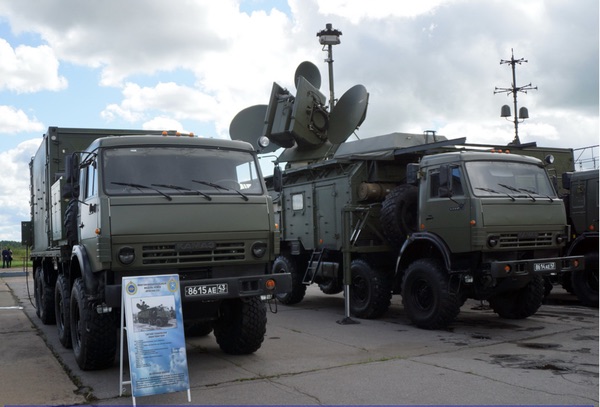 Krasukha-4 command post (left) and EW system.
Krasukha-4 command post (left) and EW system.The history of the Krasukha project goes back to the 1990s. Government contracts for Krasukha-4 and Krasuhka-2 were awarded on July 25, 1994, and December 1, 1997, but they weren’t declared ready for serial manufacture until early 2011. While the prime contractor for both elements of Krasukha is VNII Gradient in Rostov-na-Donu, serial production was assigned to NPO Kvant (Krasukha-2) and the Bryansk Electromechanical Factory (BEMZ) (Krasukha-4) in May 2011.[32] In late 2018, VNII Gradient and BEMZ signed a contract for the modernization of Krasukha-4.[33] Krasukha-2 is also being upgraded, with press reports in July this year claiming that it now can also be used against satellites. It now reportedly consists of just a single truck rather than the three used by its predecessor.[34]
Divnomorye was said to be capable of jamming radars and “other on-board radio-electronic systems” of aircraft, helicopters, and drones and, in addition to that, would also be used against “spy satellites.”
In December 2013, the director of KRET Nikolai Kolesov revealed that his holding was working on a new electronic warfare system called Divnomorye, which was expected to be ready for deployment by early 2016 (the name is apparently derived from that of a Black Sea resort in southern Russia). He described it as an improved version of the Moskva-1 complex that could be used both for electronic intelligence and as a command post and said that one of its objectives would be to take part in the country’s “space defense.”[35] Annual reports published by KRET have called Divnomorye a system for “the electronic suppression of airborne and space-based assets”. At the MAKS 2017 aerospace show in July 2017, another KRET official said that the new complex (which he didn’t mention by name) would eventually replace both Krasukha-2 and Krasukha-4, although these were still to be “significantly modernized”. He confirmed that it would target both air-based and space-based systems, adding that tests of the new complex had already begun.[36]
In May 2018, the Izvestiya newspaper quoted unnamed sources within the Ministry of Defense as saying that Divnomorye was expected to begin operational deployment later in the year. It was said to be capable of jamming radars and “other on-board radio-electronic systems” of aircraft (such as the Е-3 AWACS, Е-2 Hawkeye, and Е-8 JSTAR), helicopters, and drones and, in addition to that, would also be used against “spy satellites.” Its range was given as “several hundred kilometers” and it was expected to combine the electronic reconnaissance and electronic attack functions of Moskva-1, Krasukha-2, and Krasukha-4. All the equipment could reportedly be mounted on a single truck and be readied for use within a matter of minutes, making Divnomorye “highly mobile” and “virtually invulnerable.” It was described as a completely automated system capable of independently detecting and identifying targets and determining which electronic countermeasures to use.[37]
Analysis of openly available documents shows that the Divnomorye project started on December 20, 2012, with a government contract awarded to KRET, which in turn assigned work on the new EW complex to VNII Gradient on April 30, 2013. In fact, VNII Gradient would appear to be the de facto prime contractor for the project. Major subcontractors include TsNII EISU, NPTs Sapsan, and the Kaluga Radiotechnical Scientific Research Institute (KNIRTI). Designations seen in the documents are Divnomorye-U, U-S, U-R, U-KIZ, T, T-P, M, MU, MR, and MUSP, but it is not known what these exactly stand for.
VNII Gradient’s chief designer for Divnomorye is identified in procurement documents as Vladimir N. Vernigora, who was one of several KRET officials to be awarded a prestigious state prize in 2017 for their contributions to the development of electronic warfare systems to attack air-based and space-based radar systems.[38] One contract for Divnomorye signed in early 2018 called for “refining a program to calculate satellite trajectories,” another clear sign of its space-related role.[39]
There are no positively identified pictures of Divnomorye. Some having the name Divnomorye in the caption actually show Krasukha-2. Some of the available documentation is for the procurement of KAMAZ-6350 trucks, the same type used by Tirada-2 and Krasukha-4.[40] Earlier this year, an anonymous source tweeted a hitherto unseen image of an EW complex using the KAMAZ-6350 chassis, saying it was intended for “interfering with radio-relay and satellite communications and countering the orbital constellation of the likely enemy”. However, it is not clear if this is Divnomorye, Tirada-2, or something else.
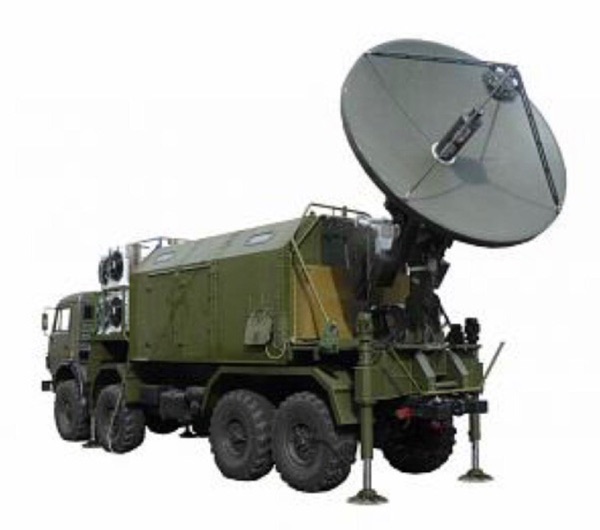 Unidentified satellite jamming truck using the KAMAZ-6350 chassis.
Unidentified satellite jamming truck using the KAMAZ-6350 chassis.https://www.thespacereview.com/article/4056/1












